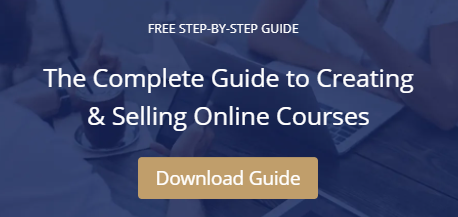Table of Contents
PS: Don’t have time to read the whole post? Download the PDF version of this!
When Johannes Gutenberg invented the printing press, the world changed forever.
Education spread to the masses. Famous Renaissance artists, like Leonardo da Vinci, learned from books and wrote new books to be passed on to the next generation.
It paid to be an author back in those days!
Today, the Internet is our printing press and we produce new content at an exponential rate. Like in the Renaissance, many people are learning new skills online, outside of their formal education.
Today, it pays to create and sell online courses.
Given that you’re reading this guide right now, you’ve probably already realized this. While books have traditionally been a great way to pass on information, online courses are more engaging and interactive, making it a far more effective method of education.
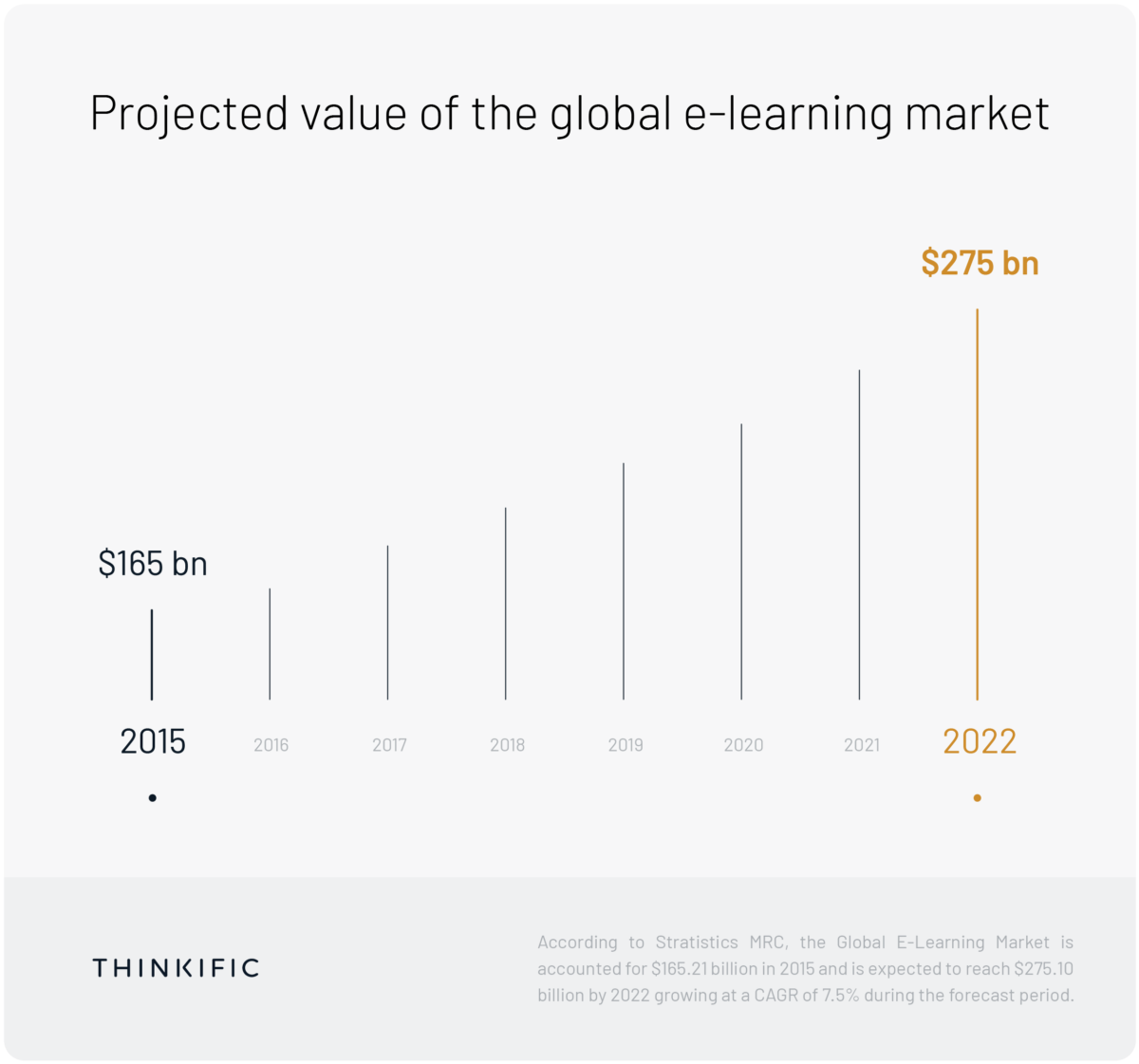
At Thinkific, we’ve helped tens of thousands of entrepreneurs create and sell more than $500 million in online courses. With our platform, you can create your online course website, upload your course content, and distribute it to people around the world with just a few clicks. We’ve revolutionized how individuals earn and learn online by building an all-in-one platform designed for both course creators AND their audience.
And having helped those people create their online courses, we know exactly what it takes. From coming up with a topic to teach, to creating the actual course content, to marketing it and attracting students, we’ve documented the exact step-by-step process used by our most successful clients in this guide.
How to Create and Sell Online Courses: The Step-By-Step Guide Click To TweetAs for how to read this guide, I suggest giving it a quick skim first, then come back to go through it each section at a time. When you finish a section, put it into action and return to the next section when you’re ready.
Let’s dive in!
PS: Don’t have time to read the whole post? Download the PDF version of this!
CHAPTER 1
Why Create Online Courses
At the height of the 2008 recession, Lewis Howes found himself broke and living on his sister’s couch. His fledgling football career had come to an end because of a fracture the year before. It was not a great time for him to be jobless and without any professional job skills.
But Lewis was driven. He wanted to become successful so he spent all day on LinkedIn, connecting with other people and diligently growing his network.
In time he got so good at networking using LinkedIn that people were asking him to teach them how they could use LinkedIn for their business. At first, he hosted in-person workshops but then he realized he needed to create an online course to scale it up.
Before creating his online course, Lewis asked his students to pay in advance for it to see if there was interest.
The next day he woke up to $6,300 in his account.
Before we start creating and selling our online course, let’s have a look at why we should even bother. The most obvious reason is to generate revenue, and indeed there are people who earn their livelihoods purely through their course sales.
However, there are additional benefits to creating online courses beyond making money. And, depending on what your goals for your business are, there are different ways to go about creating one.
Read how @lewishowes made $6300 in one day from his first online course Click To TweetOnline courses as an income source
Generating revenue is the most common reason for an entrepreneur to create online courses. This is the simplest use case – you create an online course once, and people buy it over and over again.
Of course, there’s a lot more that goes into it, which we’ll cover in detail, but that’s the allure of creating an online course. As a digital asset, it doesn’t cost much to produce, and it’s cheap to distribute. No shipping costs!
Once Lewis tasted success with that first online course, there was no stopping him. Today, he’s built a multi-million dollar business selling online courses, books, and other digital assets.
“I think now is a perfect time to start a business by sharing your knowledge.” – Lewis Howes, School of Greatness
Many other entrepreneurs are transitioning into online courses in a similar fashion.
YouTubers have historically depended on ad revenue. However, with all the video content they create, packaging it into an online course is easy. This allows them to generate a much higher income than what they get from ads.
Sunny Lenarduzzi is an expert in YouTube marketing. As a consultant, she helped companies grow their YouTube channel. Today, she teaches others to do the same in her YouTube for Bosses online course.
Bloggers publish posts that are free to read on their sites. They previously monetized their blog with banner ads and affiliate links. Now they’re realizing that creating an in-depth course is a more natural and lucrative way to monetize.
Danny Iny started the popular Firepole Marketing blog to share his knowledge of marketing. After rebranding to Mirasee, he started creating and selling online courses to monetize his audience.
Podcasters are eschewing the sponsorship model in favor of selling their own courses. This allows them to monetize their audience without interrupting their shows with advertorials for other companies.
John Lee Dumas had built one of the most popular business podcasts and was earning six-figures through sponsorships. He then created an online course on podcasting that brings in more revenue.
Authors are augmenting their diminishing book revenues by creating follow-on courses. These courses are a natural extension of the concepts they cover in their books.
Dorie Clark is a best-selling author and personal branding expert. After the success of her books, she took it to the next level with her Recognized Expert online course.
Speakers who have hit a ceiling with the number of speaking gigs they can take on are creating courses to scale past that barrier. Many of them actually speak for free because they can make it back and more with the resulting course sales.
Michael Port has been giving keynotes across the world for the last 15 years. Now he’s taken traditional keynoting off his plate so that he can focus on making a bigger impact via his online courses.
Coaches and consultants who have reached capacity and can’t trade more time for money are scaling up by creating courses as digital complements to their coaching.
Mari Smith is the leading expert on Facebook marketing and consulting for countless companies. To scale up she shares her knowledge of marketing via her online courses.
You’ll meet these people and more, including fitness experts, athletes, dancers, artists, engineers, and others who share their skills and knowledge online, as you progress through this guide.
So if you have a skill, or a passion, or an audience, or some content that people want, then selling it as an online course is a great way to generate revenue.
Learn how to create and publish your first course with Thinkific, for free!
Get the free training
Online courses for customer acquisition
Some businesses invert the model and use online courses as a way to build an audience who then go on to purchase other products.
Hootsuite, a social media management software, for example, offers free social media marketing courses on Hootsuite Academy. More than 250,000 people have taken these courses, many of which have become paying customers of their software.
We’ve done this ourselves at Thinkific. In 2016, we created an online course called Profitable Course Creator by interviewing dozens of top online entrepreneurs. The course had a nominal fee that we donated to Pencils of Promise, a non-profit dedicated to building schools in developing countries.
We ended up raising money for a great cause, but we also created a lot of brand awareness around Thinkific, while teaching would-be entrepreneurs who to create profitable online courses. A win for everyone!
If you already have a product, like a software, creating an online course will help you attract potential customers. In this case, you’d want to give the course away for free or sell it at a nominal price because your real revenue will come from your existing products.
“For Moz, educational content and helping marketers succeed has been at the forefront of our mission and the best way we’ve found to grow our community and our customer base.” -Rand Fishkin, Founder, Moz
Online courses for customer success
In this scenario, businesses use online courses as a way to train their customers on how to use their products and ensure they don’t leave to a competitor. This is pretty popular amongst companies whose products have a bit of a learning curve.
The logic behind this approach is simple: when you help your customers achieve success with your product, they tend to have higher lifetime values, lower churn rates, and are more likely to refer other customers to your business.
“An educated customer is a capable customer. A capable customer will push the boundaries of what is possible with your product, forcing innovation, reference-ability and ultimately value to your bottom line.” -Michael Litt, Co-Founder & CEO, Vidyard
Take Later, for example. Their software helps you manage and schedule your social media posts. While the software itself is easy to use, most people don’t know how to be successful with social media.
They found that people would sign up for their software, use it without much success on social media, and then leave. To solve this, they created a course that taught customers how to grow their social media following and the best way to use the software to do that.
The course was a huge success, helping them increase customer retention by a whopping 320%!
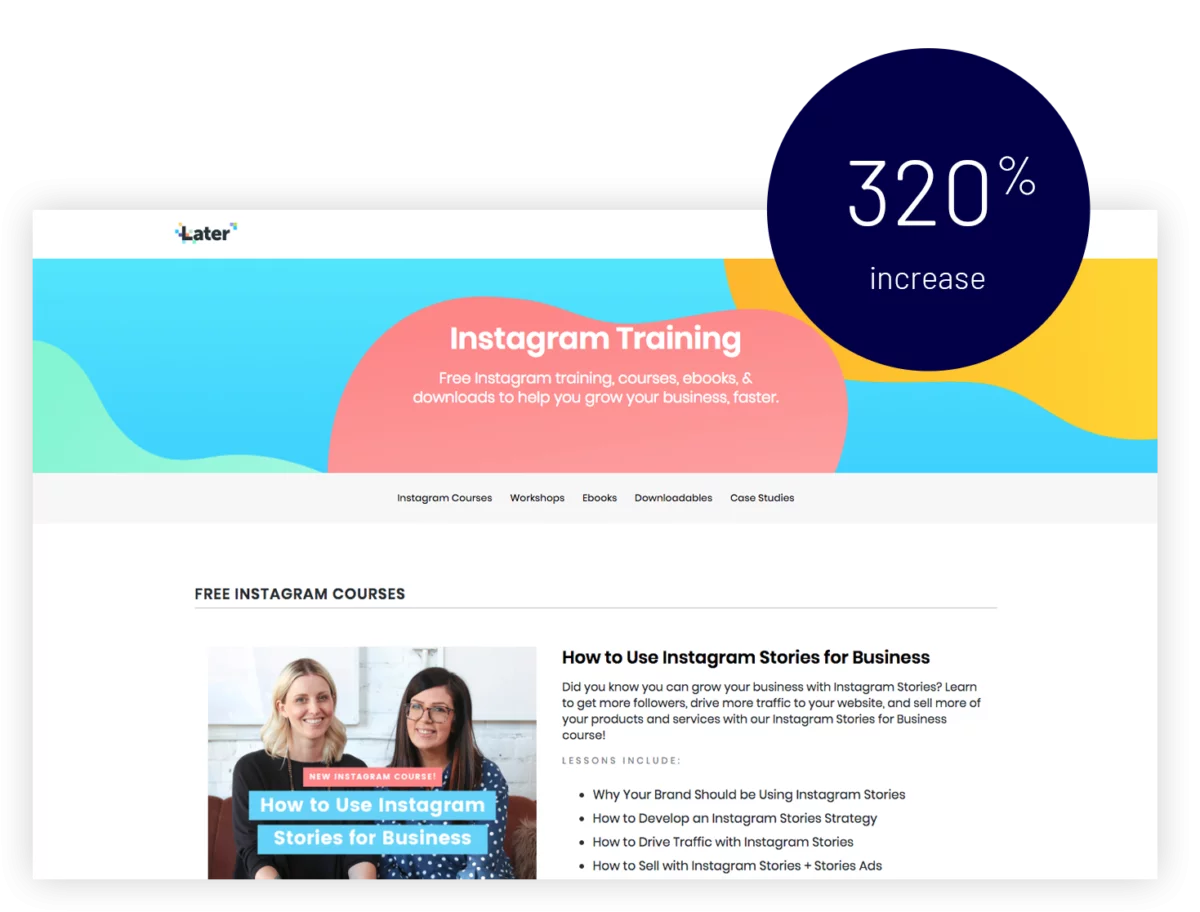
Most of the examples we will be referencing throughout this guide will relate to the first use case (generating revenue), although the concepts are the same regardless of why you’re creating a course.
Whatever your reason for creating an online course, you’ll notice a common thread – online courses are a vehicle for transformation. Your students are not coming to you for information they can find online. They’re looking to improve their lives in a certain way, and your online course is the key to that.
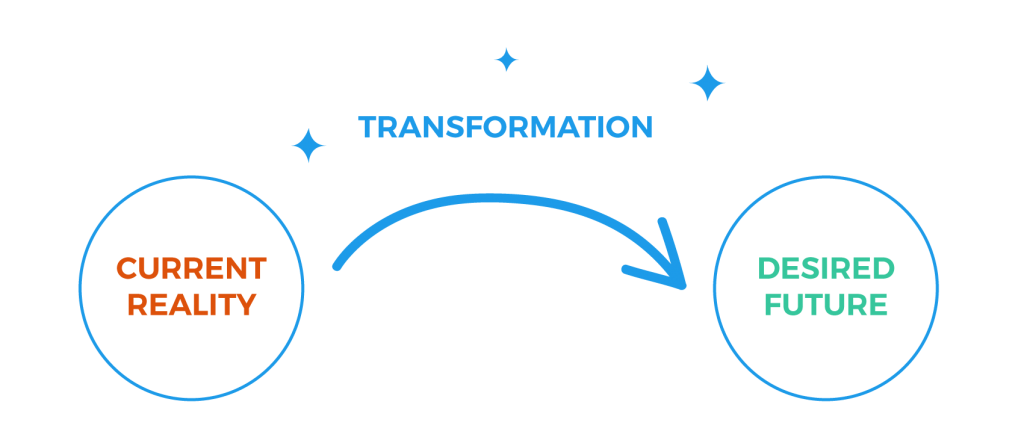
We feel incredibly privileged to help support tens of thousands of people and companies that are creating online courses, and in turn, helping to create transformation in the lives of millions of people from all over the world. And as any online course creator will tell you, the journey begins with figuring out what you’re going to teach.
“Stop banking on information to attract clients, customers and sales. Start looking at how you can create powerful, dynamic experiences that people can remember and cherish for the rest of their lives. Experiences that spark transformations…” – Marisa Murgatroyd, Live Your Message
CHAPTER 2
Pick An Online Course Topic
In 2012, John Lee Dumas had just finished a stint in the US Army and was looking for the next thing. He started listening to podcasts for inspiration but his favorite podcasts would only come out once a week.
Realizing there was an opportunity, John decided to create a daily podcast interviewing entrepreneurs. Today, Entrepreneurs on Fire is one of the most popular business podcasts in the world, with millions of listeners and over 2,000 interviews top entrepreneurs. It’s a treasure trove of business information.
John initially generated revenue from sponsorships but he soon moved to online courses to scale up. He could have created a course on any business topic, but instead of guessing, he listened to the needs of his audience. Having witnessed John’s success as a podcast host, it came as no surprise that his audience wanted to learn how to start and grow their own podcast.
In October 2013, John launched Podcasters’ Paradise. In the month of January 2018 alone, it generated over $43,000.
Like John, you want to be strategic about your online course topic because it could mean the difference between generating $0 and generating $43,000 in a month.
Topic Sweet Spot + Specific Target Audience = Winning Course
“Know your audience and stay on topic. Get rid of the fluff. Once you know your purpose with your content (which should be to generate a specific result for those consuming it), stick to teaching how they can achieve that result.” – John Lee Dumas, Entrepreneurs On Fire
If you already have an audience, it should be fairly easy to narrow down on your first online course topic. Just ask! One way to do this is to email your list with a survey. Use Typeform to quickly create one that asks them to fill out what they’d like to learn.
You can also ask your followers on social media. Facebook and Instagram have features to create polls. If there’s a clear winner from the responses, that will be a good topic to start with.
If you don’t have a large audience but you do produce content in the form of blog posts, YouTube videos, podcast episodes, or the other types, that’s a good place to start. Your online course will ideally be around the same topic that your content covers.
If you cover multiple topics, pick the most popular one and start there. You can always create additional online courses on other topics in the future.
“You’re not limited to launching one product—you can launch as many as you like. And if you ask me, that’s the definition of professional and financial freedom: a business that you can scale easily.” – Shaa Wasmund
Simon Sinek, the popular author of Start With Why, created an online course that was an extension of the topics covered in the book. The course goes into more detail around how to find your why. It’s natural that people interested in the book would also be interested in taking the course to learn more.
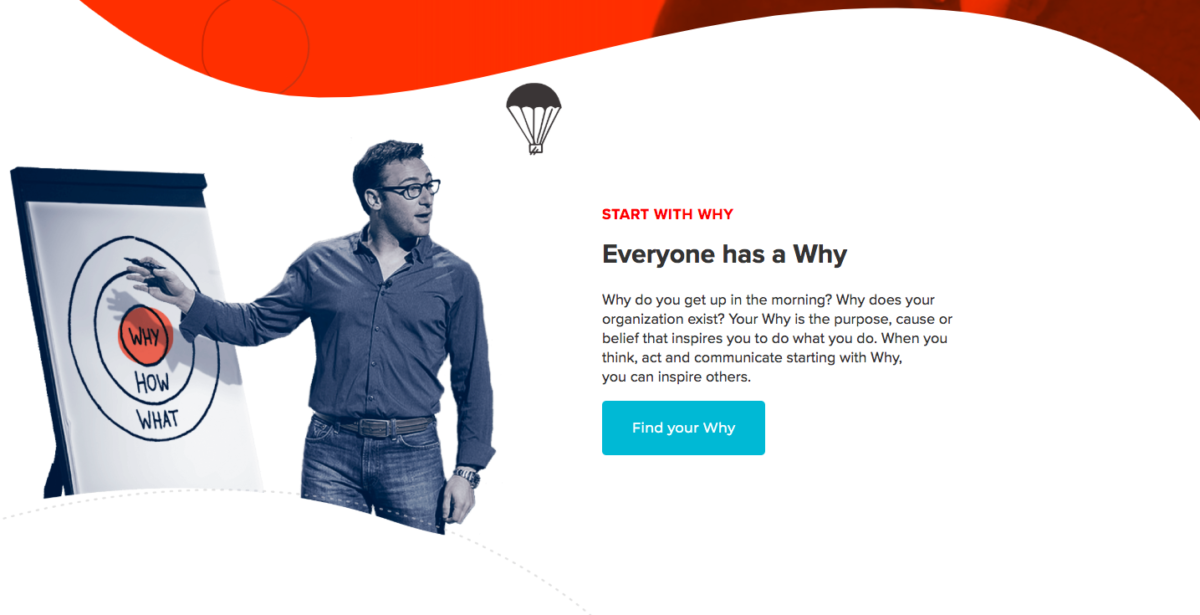
If you don’t have content either, that doesn’t mean all hope is lost. You probably have a skill that others might want to learn. Think about the things that people have asked for your help on in the past.
Deanne Love, of Hooplovers, is the perfect example. Deanne was an English teacher in Japan and she had a passion for hula-hooping. On weekends, she’d dance in the park and practice her hoop moves. It wasn’t long before onlookers approached her to teach them those moves.
Deanne realized that she could potentially teach people around the world if she created an online course. And so, Hooplovers was born. Today, thousands of people buy her courses and she even has a team of hoop coaches who host workshops around the world.

“Stay laser-focused on the results your clients will invest in achieving. Get focused by narrowing your audience, narrowing your result, and narrowing your content, and your course will instantly stand out.” – Jeanine Blackwell, Create 6-Figure Courses
CHAPTER 3
Validate Your Online Course
In 2015, Dorie Clark had just published her second book, Stand Out. The book was a huge success and became one of the top leaderships books of the year.
But Dorie had always wanted to create an online course. She knew it would help her increase her impact, reach more people, and earn more revenue.
The logical step was to create an online course that went deeper into the concepts she touched upon in her book. However, Dorie had experienced failure with a previous book topic because she had made assumptions about what people wanted. She didn’t want to make the same mistake with her online course.
For every entrepreneur out there with a successful online course, there are probably dozens of people who had a great topic and started creating the course but stopped. They were not sure if their course would generate income. The fear of failure held them back.
And that’s a valid fear because there are also dozens of people who have created online courses only to find that no one wanted to pay for them. Instead of letting the fear hold her back, Dorie decided to validate her idea and pre-sell it.
This does three things:
- It shows you if there’s actually any demand for your course.
- If you pre-sell it, you have proof that it can generate revenue.
- It builds a list of people likely to purchase when you launch.

Validate By Asking
A simple way to validate a course is to survey your existing audience. With a software like Typeform, you can create a really engaging survey. In the survey, ask your audience to tell you what topics they’re interested in. And if you have a topic in mind, ask them if it’s a course they’d buy.
Have a topic idea for your next online course? Validate it by asking your audience if they'd be interested in it by creating a @typeform survey Click To TweetIn December 2015, Dorie sent an email to her list. The survey began with a critical question: “What’s your single biggest professional challenge right now?”
A question like that allows respondents to answer in any way they’d like, unbiased by your subsequent line of questioning.
She then asked some basic demographic questions (age, gender, etc.) and asked them to rate which topics that she wrote about were most appealing to them. It turned out that becoming a recognized expert in any industry was the most popular answer by far.
Don’t forget to lean on your social and offline networks here too if you don’t have a large email list. You can drop your survey into facebook groups you’re a part of or ask your current customers when they’re buying some of your other product offerings.
Pre-Sell Your Online Course
You may also want to consider pre-selling your course. Not only does it prove that there is demand, it also generates revenue before you launch. There’s nothing like paying customers to motivate you to create that course!
“People will vote with their credit card. If they don’t actually put money down, the idea isn’t validated yet.” – Michael O’Neal
Though Dorie had enough data, she wanted to make sure people would actually pay for her course. She reached out to fifty people who had filled out her survey and asked them if they’d be willing to look at a one-page description of the course and provide feedback.
She also asked if they’d be interested in signing up for the course if it cost $500 and their reasons why or why not. Fifteen people responded, and five said yes. That’s a hit rate of 33%, more than enough to validate it.
Like Dorie, you need to come up with a one-page description first. Use Thinkific to quickly create the sales page and collect payments. Just make it clear that the course has not yet been created.

Then, send your audience to this page. You don’t need to promote it to everyone. Pick a small subset of your audience that’s highly engaged and release it to them. If you hit a certain goal, say 10 sales, consider it validated and go to the next step to create the course. If not, refund the money and go back to Step One.
People are now very comfortable with this model of pre-purchasing after the major success of crowdfunding companies like Kickstarter and Indiegogo. To incentivize your first few buyers, you can offer your course at a early bird price and quickly change it later on Thinkific with our flexible one-click pricing feature.
Thinkific customer and digital marketing agency owner Matt Kohn generated $30,000 in sales before he created his course (watch our interview with him to learn how he did it here). With the demand for online course idea validated, he proceeded to create the training for his first round of customers.
Launch a Pilot Course
After her pre-sale experiment, Dorie sent out another email to her broader audience. She was opening up forty spots in a special pilot course on becoming a recognized expert that would consist of six live webinars over a five-week period.
In exchange for sharing frequent feedback about the course (and providing testimonials if they enjoyed it), participants would get more personal access to her and at a much lower price: $500, instead of the $2,000 that the course would cost when it officially launched.
Launching a pilot course like this is a way to put in minimum effort into creating your online course, before you invest more time expanding it once it has been validated. Notice that Dorie’s pilot course was a series of live webinars. She hadn’t actually created the course yet.
The purpose of creating a pilot course is to prove that people are willing to pay for a course about your chosen topic, and to obtain feedback and testimonials from your students. As you collect questions and feedback from your students, you can improve your course by refining your content or adding additional training and resources to it.
Remember, your pilot course is your minimum viable online course, so it’s fair to offer your first group of students a reduced price to enrol in it, just like Dorie did. As you improve your course and/or add more content to it based on feedback, you can increase the price.
If you’re thinking of skipping this step you should know that less than an hour after she sent that email, Dorie had earned $22,500.
See how @dorieclark pre-sold her online course for $22,500 before she even started creating it Click To Tweet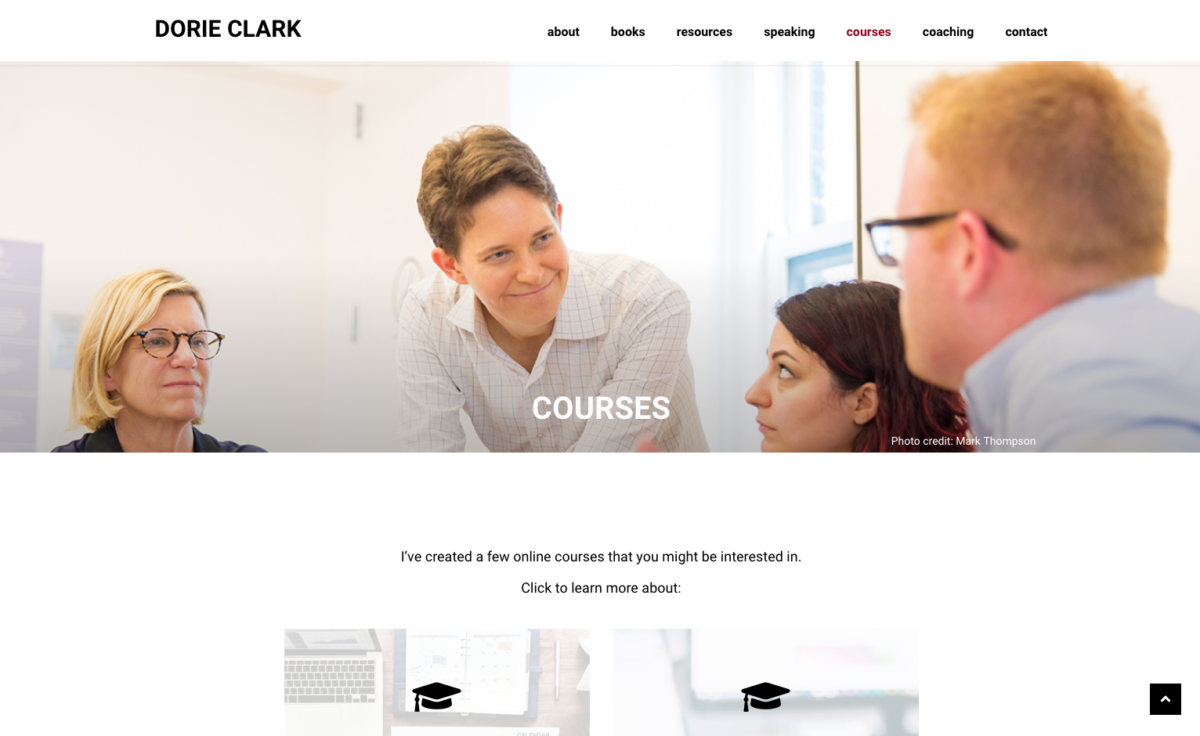
PS: Don’t have time to read the whole post? Download the PDF version of this!
CHAPTER 4
Create Your Course Content
Once you’ve validated your topic and you know that there’s demand, it’s time to create the actual course!
In most cases, an online course is just a sequence of videos. You can throw in other types of media, like images, sound bites, and PDFs. To make things interesting, you can also add in quizzes and tests, which we’ll cover later in this guide.
The core of your course will be those videos where you’ll explain the topic you’re teaching in a step-by-step manner. You can either record yourself in front of a camera, or you can record a screencast, where you’re sharing what’s on your computer screen, and talking over your actions.
Pick the type of video based on what you’re teaching. If you teach yoga, you’ll need to record yourself in front of a camera. If you teach people how to use Excel, you’ll need to share your screen.
Tools of the Trade
With that in mind, let’s start by ensuring we have the right tools. The most important tool is your computer. Technically, if your laptop or computer has a built-in camera and a microphone, you have what you need to create an online course. For better production quality, we suggest the following tools:
Screenflow – This is the best screen-sharing software out there. If your course is mostly screencasts, get Screenflow. It will capture your screen and voice as you navigate your computer and explain your actions. You can also edit the resulting video if you make mistakes.
Use @screenflow to easily create video content for your next online course Click To TweetAudio Technica ATR 2100 – The ATR 2100 microphone is a popular microphone amongst online course creators. There are many other options but this one is affordable and produces extremely crisp sound.
Logitech HD Pro Webcam C920 – This is an extremely affordable yet high-quality video camera. Just clip it on to your computer and start recording HD videos.

Additional Tools
The three tools listed above are more than enough to get started. If you’re looking for additional production value, check these out:
Canon EOS Rebel T5 DSLR Camera – If you need a camera that you can take outdoors, look no further than this DSLR by Canon.
AmazonBasics Lightweight Tripod – This tripod goes well with the Canon if you need to perch the camera somewhere.
LimeStudio Photo Video Studio – The better your lighting, the crisper your videos look. This studio in a box is a very affordable kit that has everything you need.

To reiterate, you do not need a set up like this, especially if you’re just starting out. Your computer or a camera is good enough to start with.
Create Your Course Outline
Before you jump into creating your videos, it’s worth spending some time planning out the structure of your online course and creating a curriculum. You may also want to script out the full course, or at least note down talking points. This could save you hours of retakes and editing later.
It’s best to start with the end in mind and work backwards. Think about the outcome you wish for your students after they’ve finished your course.
Write down what a student would have had to learn or do right before they complete your course. What was the last step or lesson towards finishing this course? Then, continue moving backwards until you reach a natural starting position.
Next, organize your brainstorm into a two-level hierarchy of Chapters and Lessons. An easy way to do this is to determine which parts of your learning experience are Milestones and which are Steps.
Milestones are major accomplishments and Steps are the small wins required to get to each major accomplishment. Determine the major accomplishments your student will achieve when completing the course. You can treat these Milestones as the Chapters of your online course in Thinkific.
Next, start sorting your Steps under your Milestones. Remember to treat your Steps like Lessons in Thinkific.

This stage can get a little tricky, and should start to illuminate any problems with how you’ve already structured your course. If you ever get stuck, go back to your own learning experience with the subject matter. What did you end up doing first? What did you wish you had done first afterwards?
Finally, we need to make sure that we’re not creating any extra work for us, or our future students. Take a really critical look at your proposed curriculum. Try and get rid of any extras or unnecessary steps. Ask yourself things like:
• Is this Step crucial to getting to this Milestone?
• Is my student actually learning anything here?
• Can these Steps be combined?
• Would my audience already know this going into the course?
• Is this Chapter too long? Too short? Can I combine it with another?
• Would I have taken this course when I was getting started?
At the end of this exercise, you should have a solid structure for your course.
Create Engaging Content
Now you have the tools, and you know what content you want to create, down to the individual lessons. It’s time to start shooting!
At this point, you want to keep your student’s success in mind. People often purchase online courses but never finish them for a number of reasons. We’ll cover ways to tackle this later, but you should know that making your content engaging and exciting will go a long way to keeping students interested.
So for each video you create, make sure it has all three of the following:
- Highly useful or educational so that students learn something.
- Entertaining so that students don’t get distracted.
- Inspires action so that students convert theory into results.
“Epic content is any type of content that’ll ultimately change the game for those consuming it. It should always be at least educational, inspiring or entertaining – and if possible, all three rolled into one.”– Chris Ducker, chrisducker.com
Make Your Content Educational
Your goal when creating online course content should be to create the best piece of content about your specific topic. In order to accomplish this, you’ll need to do some research to find out what you’re competing against.
As you research competing pieces of content, look for gaps to fill or an opportunity to cover the same topic but from a difficult angle. Your content needs to be better, more detailed, or different in some way in order to stand out.
Clarify the big idea for your content, and then organize all of your supporting insights and ideas (your “raw material”) into themes and/or steps that support your big idea. Your goal is to present your ideas in a methodical and logical sequence that guides your audience from Point A (their current reality) to Point B (their desired reality).
Share as much information about your topic as you can, to the extent that it is still useful and relevant to your topic, but don’t overwhelm your audience with too much information. If your video gets too long, break it up to help your audience process your information effectively.
“Start with the key insight that, if internalized, will change everything for the reader. Then build on that until everything that needs to go with it for coherence and clarity are included.”– Danny Iny, mirasee.com
Make Your Content Entertaining
You don’t need to produce a Netflix show here but there are some principles that you can borrow from them to keep your students engaged.
Start with a hook – Most TV shows start with an interesting scene that makes you want to watch all the way through to find out what happens next. In the same way, you can start your lessons with a hook or a bold promise of what’s to come.
Evoke an emotional response – Most people won’t remember what you say, but they will always remember how you made them feel. For your content to be memorable, it must evoke an emotional response. If your content doesn’t make your audience feel something, they will soon forget it.
Challenge your audience’s assumptions – Don’t be afraid to challenge your audience’s assumptions about your topic. If the current trend in your industry is to do things a certain way, don’t hesitate to go against the trend and recommend a different solution. Telling people what not to do is often just as valuable as telling them what to do.
Tell a story – The best TV shows are really just great stories. In the book Building a StoryBrand, author Donald Miller emphasizes the importance (and effectiveness!) of using storytelling in your content as well. The more you tell stories that your customers can relate to, the more likely they are to engage with your content.
Finally, the best piece of advice we can give you is to just be yourself. If you’re naturally funny, don’t curb those instincts because your topic is serious. Conversely, don’t force yourself to be funny. By being authentic on camera, your students will connect with you more.

Make Your Content Inspirational
At the end of the day, no matter how educational or entertaining your content is, if your students don’t actually do anything with it, they won’t get results.
To inspire your audience to change and/or take action, your content should address the problem they want to solve (their pain/current reality) as well as the benefits of your proposed solution (their pleasure/desired reality).
You should also always include a clear next step (a call to action) for your audience to take at the end of each video lesson. It could be an assignment, a quiz, or simply that they should move to the next video.
Finally, it’s not enough to just tell students what to do. You also need to help them believe in their ability to do it. This concept is known as self-efficacy, which is defined as a person’s belief in their ability to succeed.
If your audience doesn’t believe they can do something, it doesn’t matter how clearly you articulate the required steps to them, they won’t take action. They need to believe that the new reality you’re promising them is possible for them.
The way you do this is through social proof. Show your audience examples of other people just like them that have followed the steps you are teaching and achieved the result you are promising. The vast majority of your audience needs to see social proof before they will take any action.
“The real value of any educational content is when it’s applied. You need to get the viewer to actually apply what they’ve learned, and to do that, you must make it a must for them. Make whatever it is you want them to do be irresistible. That often is done by explaining the benefits (the pleasure), as well as the consequences (the pain) of not taking action.”– Stefan James, projectlifemastery.com
Alright, that’s enough theory. Go shoot your videos and finish creating your online course!
One final piece of advice, don’t get caught up in trying to make it perfect. That’s another reason why most people don’t actually launch their courses.
The beauty of online courses, unlike a book, is that you can always update it. Create your videos now, no matter how unpolished you may think they are, put them online, and then refine them over time as your students give you feedback.
CHAPTER 5
Host Your Online Course
Chris Newman is a professional drone pilot who specializes in remote-controlled aerial videography and photography. In April 2014, Chris published a short video on his YouTube channel to announce that he was going to create a course about drone flying.
Chris already had a large library of videos from his drone. With the addition of some how-to content, he had a great starting point for his online course. He was already using YouTube to share many of these videos but he needed something where people couldn’t access his course without paying for it.

He needed to create a site with a sales page, the ability to upload and host his videos, collect payments through an online credit card form, and instantly let his customers stream said videos.
There are 3 ways to do this:
Option 1: Self-Hosting
As the name suggests, you host the videos on your own with this option. This means renting a server, setting up a website on it, setting up a payment processing system, and so on.
There are software like WordPress for creating the site, and plugins for the rest, but at the end of the day it still requires a lot of technical knowledge and is very time-consuming to set up. Not to mention that if things break down, you’re on your own to fix it.
When Chris created his online course, he used his WordPress website with an e-learning theme to host it. With his course up and running, he started running ads and hosting webinars to promote his course. One time, after spending about $1,500 on ads, he drove so much traffic to his course website that it crashed.
When the same thing happened a second time, he knew he needed to find a better system to host his course.
Option 2: Online Course Marketplaces
Chris had heard of marketplaces like Udemy, where you simply upload your videos and let them do the rest. They promote it to their database of students, they collect the payments, they ensure that students can access the videos.
It sounds great but, at the end of the day, they control everything. You have to comply with their terms and conditions, and you’ll often have restrictions like how much you can price your course at or how many times you can email students. They also take a massive cut of your sales.
It was important for Chris to have complete control and flexibility when it came to pricing his course. He wanted to be able to create discount codes for his online course so that he could offer a special price for certain people (such as people who attend his webinars, for example). He also wanted to give his students the option to pay for his course in a series of monthly payments rather than pay the full price upfront.
Option 3: Learning Management Systems
Online course platforms, or Learning Management Systems (LMS), are the best of both worlds. They give you full control over everything and they’re very easy to set up.
Thinkific is one example. To sell your online courses on Thinkific, all you have to do is sign up for an account and upload your course content. Thinkific has all the features you need to then sell and deliver that course.
Payment systems are already built in so all you have to do is set your price. With a few clicks you can change the branding and design of your entire site. You can create powerful sales pages for your courses with our drag-and-drop builder.
The learning experience for your students will also be a lot better. Your course content is delivered to them in an intuitive interface, and they can even access it on their phones. You can also add interactive elements like quizzes and surveys.
“Thinkific is a very full-featured online course package. For us here at DottoTech, we’ve really rebuilt our business around using Thinkific to deliver much of our content.” – Steve Dotto, DottoTech
Having tried other options, Chris decided that Thinkific met all his criteria. He opted for our Business Plan, where in exchange for a fixed monthly fee, he keeps all the revenue from his course sales.
And thanks to our Bulk Upload feature, Chris was able to upload all of his course content in just a few minutes.
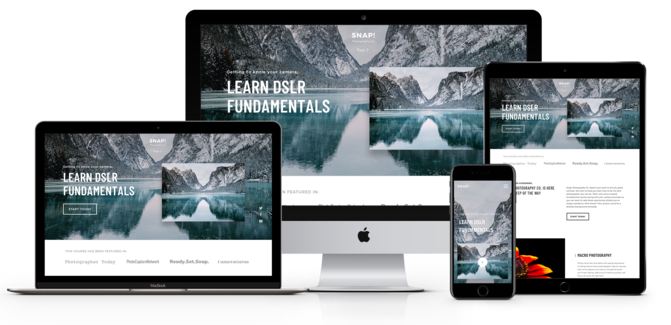
Learn how to create and publish your first course with Thinkific, for free!
Get the free trainingCHAPTER 6
Price Your Online Course
Before we launch our course to the public and start generating revenue, there’s a little question we need to answer first. How much are we going to charge?
This bears more than a few minutes of thought because incorrectly pricing your online course might lead to lost revenue. Price it too high and people may not buy. Price it low and you’re leaving money on the table.
Additionally, the price of your course has a direct impact on virtually every aspect of your online course business – from the marketing to the type of students you attract, to how much support and attention you can provide to your students.
The question of online course pricing also comes up a lot in our Facebook Group, and among online instructors in general. There isn’t a one-size-fits-all response but there are some guidelines you can follow to arrive at your unique price point. We’ve included the salient points in this guide, but you can also read this guide to online course pricing if you want to dig deeper.
Choose A Business Model
We need to start by picking a business model. There are two broad categories – one-time or recurring (also known as a membership model).
With a one-time model, students pay you upfront or in installments to access your online course. Typically, once payment is complete they have unlimited access to your course. This is the model that Chris Newman uses.
With the membership model, students pay you on a regular basis, usually monthly. This works if you always have something new for them every month. If they cancel their subscription, they lose access to your program.
“Your membership site is going to involve the addition and delivery of fresh, new content over time as opposed to being something that’s a finished article that is static and is complete in terms of the learning objectives. The average membership site has regular ongoing content. Usually there’s a a community element to it, sometimes there’s a coaching element.” – Mike Morrison, The Membership Guys
Mimi G uses the membership model for her Sew It Academy where she teaches people how to sew their own clothes. The reason Mimi charges a monthly subscription fee instead of a higher one-time purchase price is because she didn’t want her students to have to invest a lot of money up front to learn a new hobby. She also wanted people to be able to join whenever they want, do as much or as little as they want, and move at their own pace.

You can also combine the two models to form a hybrid where people pay a lump-sum for the core online course and then join a membership for ongoing coaching or mentoring.
The simplest way to figure out which model works for you is to ask yourself if you’re going to keep churning out new content every month, or if your course can just be consumed in one go. If it’s the former, use a membership model. If it’s the latter, use a one-time model.
The following guidelines are based on the one-time model, but they apply to memberships too.
Avoid Low Prices
The first guideline is to avoid selling your online course for a low price point, no matter how tempting it may be. There are a few reasons for this.
It degrades your course’s perceived value. I may get into trouble for saying this but a purse is a purse, whether you buy it from Burberry or a street vendor. However, Burberry gets away with astronomical prices because of the perceived value that a higher price point lends to its products. Conversely, when a product is priced cheaply, it’s often seen as lower quality.
Your margins on marketing will be too low. This is especially true if you’re running ads to your course. You may find that spending $500 in ads results in five sales. So if your course is priced at less than $100, you’re actually losing money.
Competing on price is a race to the bottom. No matter what price you set for your online course, someone out there will always be able to beat it. Customers that are loyal to the seller with the lowest price are not the kind of customers you would want anyway. Focus on marketing your online course to people who will respect the value of it, and who aren’t going to cancel their purchase and ask for a refund the moment they find a similar course that is cheaper.
It makes it difficult to attract affiliates and partners. A really effective way to market your course is via Joint Venture Partnerships, where you get someone with a large audience to promote your course for an affiliate commission. But, if your course has a low price, the commissions will be too small for anyone to be interested.
It takes just as much effort to sell a low priced course as it does to sell a high priced one. This might surprise you but it’s true. The sales process you guide someone through in order to sell a lower priced online course probably won’t be much different from the process you guide them through to buy a high priced one. We’ll explore this more in the next section on launching and marketing your course.
Of course, that doesn’t mean you should never have a low-priced course. There are times when it makes sense to give it away free or at low cost to attract leads like Hootsuite and Later, or if you’re doing a pilot course, like we covered in the previous chapter.
However, if your main aim is to generate revenue and your online course provides a lot of value, then price it higher.

When The Price Is Right
So higher is generally better when it comes to pricing. As we know from our Economics classes, demand falls as we raise our prices. The rate at which demand falls helps us determine a sweet spot where we can maximize revenue.
Let’s say we start by selling our online course at $1,000 and 10 people buy it. That’s $10,000 in revenue. If we double our price to $2,000 and 7 people, that’s $14,000 in revenue. So we’re better off selling it at $2,000 even though fewer people bought it.
But, if only 4 people buy at $2,000, then our revenue is $8,000. The earlier price of $1,000 would have been better.
Ideally, we want to test out different price points so that we can figure out where that sweet spot is. That’s exactly what Greg, our CEO and Founder, did with his first online course. Starting with a price of $29, he gradually increased his price over time. After several increases, he eventually determined that $389 was the optimal selling price for his course.
Here’s a graph to show you what testing different price points until you experience resistance could look like:
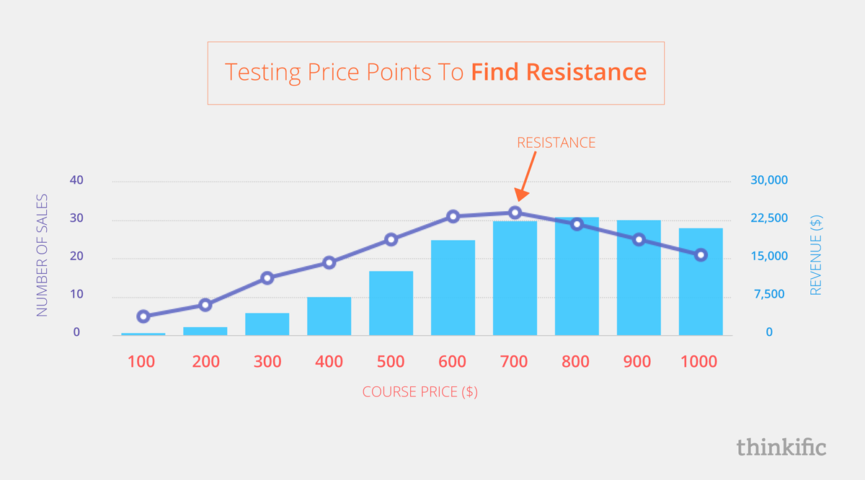
Greg started with a really low price, which we don’t recommend for reasons already covered. It’s best to start at a higher price in the ballpark of the sweet spot and then go from there. To determine what that starting price is, follow these guidelines:
Price based on value, not length. Your students aren’t paying you for the number of hours of content you have in your online course. They’re paying for the results that your course promises them. Think about how much your students value those results and what they’d be willing to pay to get that result.
If possible, try to actually quantify the value of the outcome your students can achieve. If taking your online course is going to help someone earn a promotion at work, for example, that is an outcome that can definitely be quantified. They would be willing to pay $1,000 if it helps them get a $10,000 raise.
Consider the cost of your customer’s alternatives. How else would someone learn to achieve the outcome your online course helps them achieve? How many months or years of trial and error would it take? How much money would they have to spend to hire a coach or consultant to help them? Price your course as a more affordable option.
Add Value To Increase Prices
You may find that when you first start out, your sweet spot price point is pretty low. The market has decided that they don’t want to pay above a certain price for your course, based on the value it delivers.
That doesn’t mean your course is a failure. As mentioned earlier, the beauty of an online course is that you can always improve it. If you take your students’ feedback into account and continuously add more value, you can start to increase the pricing. Here are some methods to do that:
Offer one-on-one or group coaching. Both of these methods are great for holding your students accountable for completing your course and providing personalized feedback to them.
Host a monthly live call with students. You can use that time with them to answer specific questions, delve into a specific topic in greater detail, or even invite a guest speaker to share their insights with your students.
Include downloadable resources such as worksheets, templates, checklists, and resource guides. This gives your students more control and enhances their learning experience.
Offer a payment plan. This is a proven way to increase sales of an online course with a higher price point. Many people prefer to spread the cost of a course over an extended period of time rather than pay for it in full up front.

Form partnerships to offer software, resources, or other courses. If your course recommends specific resources, tools, or software to your students, then a great way to increase the value of your course is to partner up with the sellers of those resources to create a special offer for your students.
Offer a completion certificate. Course completion certificates are an effective value-add because they give your students something to “show off” once they’ve completed your course. They can also be great for increasing student engagement because the reward of receiving a certificate helps give your students an additional incentive for completing your course.
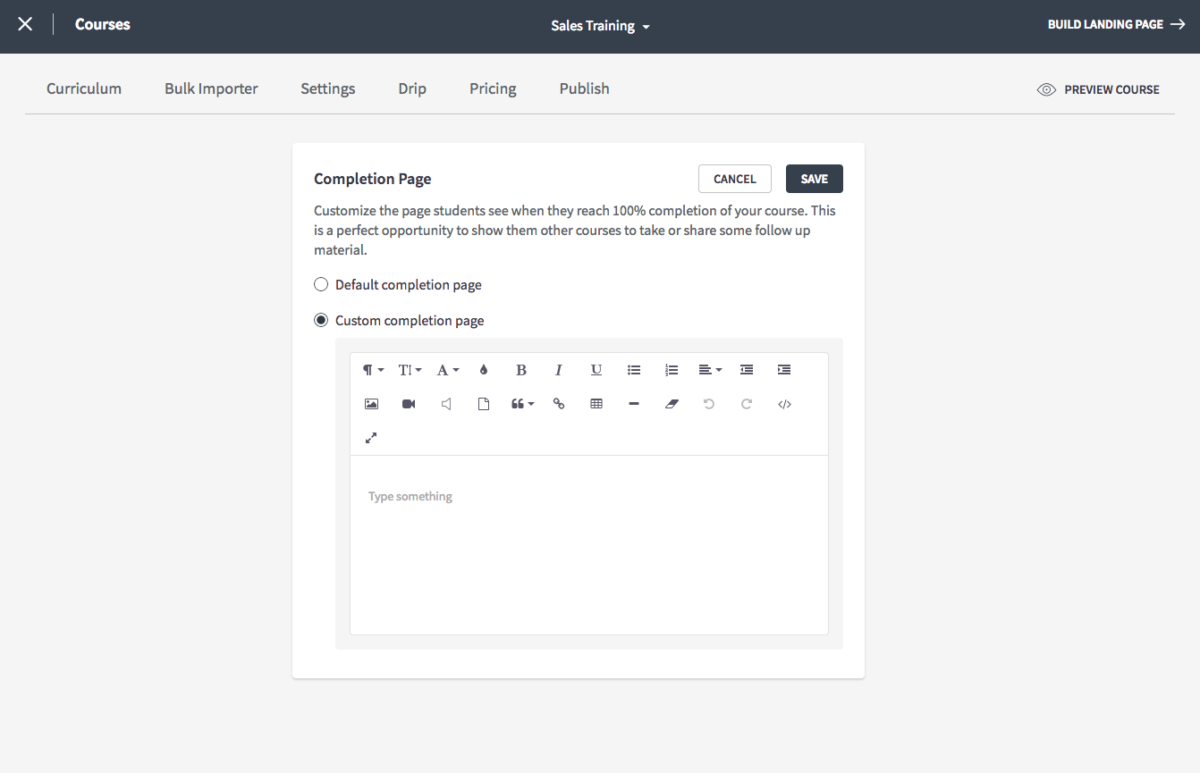
Create pricing tiers. Buyers love to have different options (it’s a psychological thing). If you only offer one specific price for your online course, then they’re most likely going to look at competing courses as their other options. When you create different price tiers for the same course, you satisfy your buyer’s need to compare different options.
While it’s worth spending time thinking of your course price, you don’t want to get stuck on this step for too long. If you’re still unsure, just pick a price that you feel is affordable but not too low, and start with that. You can even ask a few people what they’d be willing to pay for your online course.
The point is to just start and then updated the prices later as you enhance the course.
CHAPTER 7
Create A Course Sales Page
The final piece before you hit publish is to create the sales page of your online course (also known as your course description, landing page, or sales letter). This is the page that describes your course, but more importantly, persuades someone to enrol in it. It’s the page that people visit before they decide to sign up – or not sign up – for your course.
Step 7 on launching and marketing your course will be all about driving traffic to this page, so it’s important to have your sales page in place first.
Before we go into what makes a good sales page, you need to know the answers to these three questions:
Who is this course for? No one buys a course, they buy solutions to their problems. That means your online course solves a specific problem for a specific group of people. If you’re teaching Excel, then your target audience could be finance students.
What does it help them do? This is where you need to articulate what results your online course helps your target audience achieve. The more specific you are, the better. With the Excel course, you could be making them three times more productive.
Why is that beneficial to them? Try to translate the results they get into real world benefits. If your Excel course makes them more productive, then the benefit could be that they earn a better salary, or get a high-profile finance job.
Once you’ve answered these questions, tie them together in a single sentence using the framework below. This is your Unique Value Proposition, and it forms the core of your sales page.

The Anatomy of a Sales Page
Wouldn’t it be great if we could just paste our Value Proposition on our sales page and call it a day? If only it were that simple!
However, you need to do a little bit more to convince people to shell out the fat stacks. You’ll need to unpack your Value Proposition in your sales page using the following 10 elements in order.
A Compelling Headline
The purpose of this headline is to grab your reader’s attention and make them want to keep reading. Think of it as the ad for your sales page. If all your target audience sees is your headline, would it make them want to keep reading?
The Opening Story
Next, present the problem that they are experiencing and remind them of the cost of not solving it. Show your reader that you understand their current pain or frustration by explaining how you too experienced it in the past. This serves as a build up to the solution (your course) which comes next.
“Amplify the consequences of not solving the problem, and the aspirations they hold for the future. This is really the key to making sales, and it is probably the most neglected step in the process.” – Ray Edwards
The Solution (Your Online Course)
If you’ve described the problem well enough, and demonstrated the costs of not solving it, presenting your course as the solution should be the natural next step. This is where you explain what exactly your course teaches and how it can save your students a lot of pain and frustration.
The Benefits
Like we did with the value proposition exercise, we want to clearly state the benefits that our course brings to our students. If you have a number of different benefits, separate it out into bullet points so that it’s readable.
Bonuses
List out the bonus materials and resources that are included in your course. We covered some of these in the section on adding value to your course. These are meant to supplement your course material and enhance the overall learning experience for your students.
Testimonials
If readers are still not convinced that your course can do what you promise, you need to show them proof. Include testimonials from past students and describe how your course helped them.
With Thinkific, you also have the option to collect reviews from your students, and display those reviews on your course sales page.

Credibility
This is where you tell readers who you are and why they should trust you to teach them. You wouldn’t take fitness advice from someone who has never been to the gym, would you? Feel free to boast about your achievements and showcase your expertise here.
Frequently Asked Questions (FAQs)
The FAQ section should overcome any last minute objections and concerns that your reader may have. If you were giving a 1-on-1 sales presentation of your course to a potential student, what questions would they likely ask you before they decide to buy your course?
Pricing
Technically this part is taken care of for you by the Purchase Buttons that are automatically added to the bottom of your Thinkific course page. That being said, it is still a good idea to actually tell your reader to sign up for your course. Never assume that you reader knows what to do next.
Risk Reversal
It’s all well and good to promise readers you can solve their problems and that you’re the best person to do so. But there will always be a nagging thought on their minds – what if your course doesn’t live up to the promise? The risk reversal is the answer to that.
A common risk reversal technique is to offer a 100% money back guarantee within a specific period of time, such as 30 days. This takes all of the risk of buying your course off their shoulders. You’re basically saying, “I’m so confident that you will like my course that I’m willing to give you all your money back if you don’t.”
If you include all these elements in your course sales page, you should have something that’s really compelling and leads to a high conversion rate. If you need more help with this page, check out our detailed guide here.
Creating a sales page like this for your online course is pretty simple in Thinkific. Our page builder allows you to create the sections mentioned above and add any content you want to it.
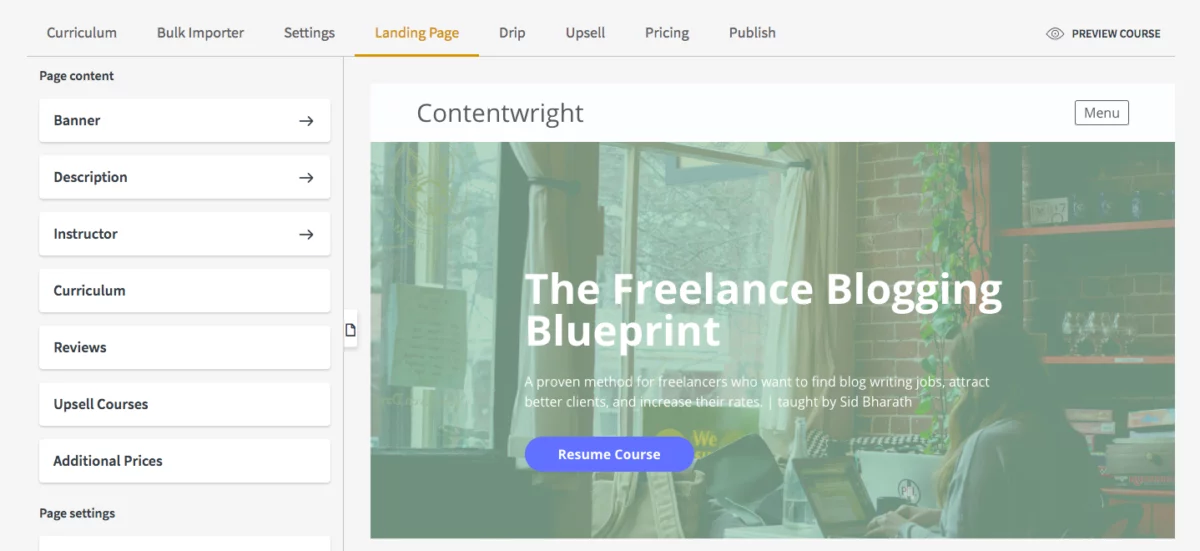
CHAPTER 8
Market Your Online Course
Thinkific makes it extremely easy to design your course site, upload your content, set a price, and publish it. But your journey really only starts when you hit that publish button. Now it’s time for you to start promoting your online course and generating revenue.
Let’s look at the journeys of two successful Thinkific course creators to see how they did it.
Nine years ago, Elizabeth Rider started a blog out of her passion for health and wellness. Her blog began as a way to share her insights, nutrition tips, and healthy recipes for anyone interested.
As her readership grew, she realized the blog was something she could potentially monetize. She started by offering 1-1 coaching to her readers and subscribers. When she realized that she couldn’t scale it, she switched to selling online courses. Having already built an audience, her course was an instant success.
Today, Elizabeth’s courses generate hundred of thousands of dollars in revenue for her. And it all started with a small blog years ago.

John Michaloudis, on the other hand, didn’t start with a blog. As an accountant, John was a master at using Excel. He found himself helping others use it and realized that there was an opportunity to package his knowledge into an online course.
Without the advantages of having a large readership or email list, John’s course only made a handful of sales in the early days. But that didn’t deter him. Day by day, week by week, John kept promoting his course and slowly increasing sales.
Today, his course generates over $20,000 per month in income for him, allowing him to leave his job and focus on selling more online courses.
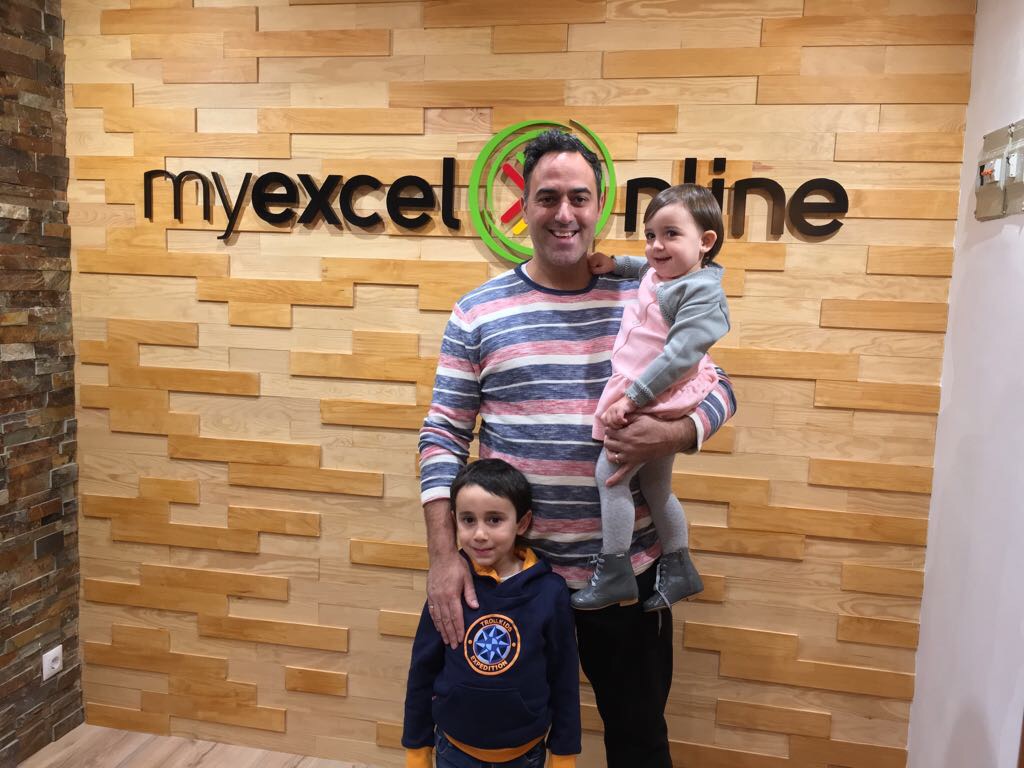
Chances are your journey is similar to one of these two. You may be a blogger, author, YouTuber, or someone with an audience like Elizabeth and you’re looking to monetize that audience with your online course. You have a head start here because you can promote your online course to your email list and make sales as soon as you hit publish.
But, if you’re like John, those sales won’t come right away. You’ll need to constantly promote your online course and it may take months before you start to earn life-changing income.
Either way, you’ll need a sales funnel before you actually dive into marketing tactics. A marketing tactic is a method for spreading the word about your online course. Running ads on Facebook, for example, is a marketing tactic.
A sales funnel, on the other hand, is the entire process that you guide your potential students through, and that ends with them making the decision to enrol (or not enrol) in your course.
In this post we’ll cover setting up a sales funnel for your online course. As for the actual marketing tactics that drive traffic to your sales funnel, head over here and pick one of the many we’ve described!
The Customer Journey
Sunny Lenarduzzi is an award-winning video, social media and online business strategist. She built a successful business helping other companies utilize video marketing and social media effectively. As she started taking on more clients, she created YouTube videos for questions that she commonly received from them.
Over time, her YouTube channel started gaining popularity and Sunny realized that she could create an online course around this. That’s how her YouTube for Bosses course was born.

To launch her course, Sunny set up a live stream boot camp within her Facebook Group. Her plan was to provide a series of free training sessions and then sell her online course at the end of the boot camp.
“The marketing of it was super fun because we did not do paid advertising. We did 10 days of live training, and every day we were teaching a different tip about YouTube. For the first week, it was just straight value. And then on the sixth day we pitched the program, and we had a 90% conversion rate.”
A 90% conversion rate is virtually unheard of but Sunny did this because she understood why people buy.
When @sunnylenarduzzi launched her first online course, she had a conversion rate of 90%! See how she did it Click To TweetEvery customer goes through a journey that culminates in buying your online course and achieving that transformation. They start in what’s called an ‘Awareness’ stage, where they are aware that they have a problem that needs solving.
As they start to explore possible solutions to that problem, they move into the ‘Consideration’ stage. And finally, when they’re ready to pick a solution, they move to the ‘Decision’ stage.
So telling people to buy your course by posting it online or putting it in an ad won’t work, because most people are not yet in the ‘Decision’ stage. Some are still considering solutions, others are only aware that they have a problem, or not even.
That means you need to be reaching them at every stage of the journey, not just right at the end.

The reason Sunny was so successful was that she didn’t pitch her course immediately. She first created YouTube videos for people in the Awareness stage. They were aware of the fact that they needed to be utilizing video marketing, and Sunny was their source of information on this.
As they moved into the Consideration stage where they considered different ways to incorporate video into their marketing, she invited them to the boot camp. By showcasing her expertise, her viewers became convinced that Sunny’s method was the solution they were looking for.
They were now in the Decision stage so when Sunny presented her online course as the solution they had already decided they were going to get it.
Now Sunny primarily used video, but you can use other content types – blogs, podcasts, email, and so on. For example, when people are in the Awareness stage, you could give them a free checklist in exchange for their email. Then, via email, you could invite them to a webinar. Finally, on the webinar, you could pitch your course and send them to your sales page.
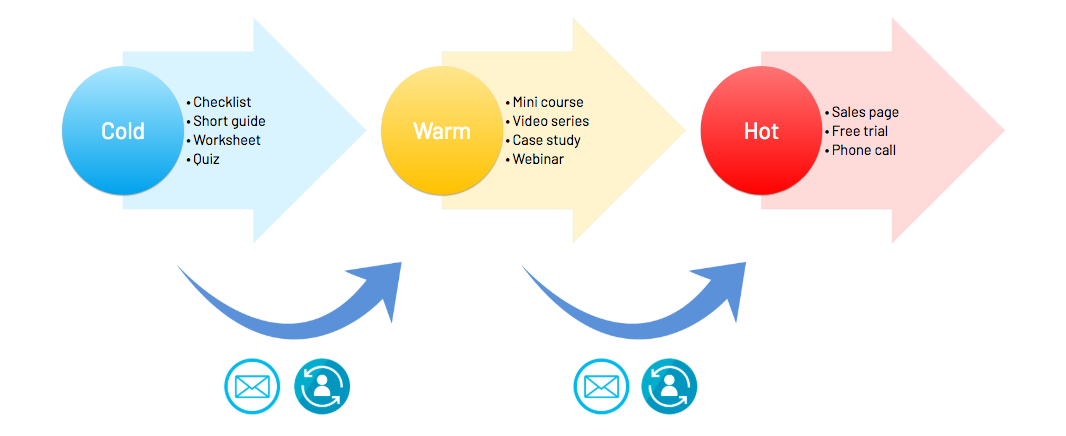
Building A Sales Funnel
Now that you understand how customers decide to purchase, let’s create a sales funnel to mimic that journey. The first step, like Sunny did, is to create content that your target audience is interested in.
So for example, if you have a course on how to train your dog, it would be pretty hard to write an article that covers everything someone needs to know about training their dog (hence the reason you would create a course). But what you can do is tackle a smaller problem that is a part of the overall dog training process.
Here are a few problems that dog owners often face when training their dogs:
- Their dog won’t stop chewing their furniture
- Their dog keeps peeing in the house
- Their dog pulls too hard when being walked
- Their dog barks at strangers (how rude!)
Every one of these problems would make a great blog post that someone who is trying to train their dog would find helpful. In fact, here are some ideas for headlines that could be used for these blog posts:
- How to train your dog to stop chewing furniture
- How to train your dog to stop peeing in the house
- How to train your dog to stop pulling when walking them
- How to train your dog to stop barking at strangers
When people visit your site to read your content, offer an incentive for them to sign up to your email list. Sunny had them join her Facebook Group. The point here is that you want some way to communicate with them.
To give you an example, one of the most popular articles on our blog is called How To Price Your Online Course. As you can probably guess, this article helps online course creators (our target market) solve the problem of not knowing what to charge for their course.
We created a Course Pricing Workbook (a fillable PDF document), which we offer as a free resource in exchange for someone’s email address.
(See what we did there?)
Since publishing that article earlier in 2016, we’ve had over thousands of potential customers all from a single article! Not bad right?
Again, not everyone who reads your blog post will subscribe to your email list to get the free resource, but the ones that do are giving you permission to communicate with them.
Once you have their email addresses or some way to communicate with them, create a sequence that leads them to purchasing your course. The idea is to provide a lot of value up front to establish your expertise and build trust, before unveiling your online course.
Sunny did this with a 10-day live bootcamp. You can do this with emails or a webinar. An email series would just be a sequence of emails that start by talking about the problem you’re solving and then slowly build up to announcing your online course. A webinar would follow a similar format where you start by giving out value before talking about your online course. Have a look at our guide to creating webinars for more information.
Marketing your online course
Now that you have a sales funnel, it’s time to drive traffic to it.

In very broad terms, there are 4 sources of traffic and sales to your course page: organic traffic from search engines, paid traffic from ads, social media traffic, and referral traffic from affiliates, partners and students.
Organic Traffic
Organic is the holy grail of marketing because it’s “free” traffic. I put free in quotations because it takes time and effort to get there. But when you’re there, you have people visiting your site because the first search result on Google for “learn Excel online” was your course. Here are a few ways to build that up:
SEO
Search engine optimization is about making sure the search engines, like Google and Bing, know that your site is out there and is the right site to surface for certain searches.
You start by deciding which keywords you want to rank for. Use a tool such as Google’s Keyword Planner or BuzzSumo to identify the most popular keywords related to your course topic.
Let’s say you want people to find your site if they search for “Excel courses” or “Learn Excel online”. The first thing you need to do is make sure your site has these phrases and keywords in it.
Thinkific allows you to add these keywords to your course pages so start there. There’s a lot more to SEO than this, but it’s a good starting point.
Related: 50+ Online Course Ideas (Plus 4 Steps To Refine Them)
Blogging
There are only so many keywords you can optimize your course site for before it starts sounding robotic. Blogging allows you to continuously create new content optimized for various keywords and phrases.
Elizabeth Rider’s journey started with blogging. She wrote a lot of content around nutrition and dieting, and some of her blog posts rank high for those keywords. They attract organic traffic, and some of those visitors go on to look at her course offerings or sign up for her email list.
Using Thinkific, you can also create a Sales Widget for your course and place that sales widget anywhere on your blog.

Related:
- AI for Blogging: Best Tools & Strategies To Use
- The Complete Blogging Guide for Beginners (Guide + Checklist)
YouTube
YouTube is the second most-visited search engine in the entire world (after Google). Some videos can even rank higher than websites in search results.
Start a YouTube channel about your course topic and publish helpful videos on a regular basis. Include a link to your website or course in your video descriptions. Here’s a more detailed guide on YouTube Marketing.
Related:
Quora
Quora is a crowdsourced Question and Answer site where you can ask a question and have it answered by anyone else in the world. The top answers get upvoted by the community so that the cream rises to the top.
You’ll likely find questions related to the topic you teach, which means you can answer them yourself and link back to your site. If your answer is good, it will get upvoted and gain visibility. Quora questions often rank high on Google searches too.
Podcasting
Podcasts have risen in popularity in recent years and many of the top podcasts organically attract listeners and traffic from their podcast directory listings.
Think of podcasting as blogging in audio form. It’s another way to create content that attracts more customers.
Guest Posting
Writing posts on other blogs that already have a readership allow you to tap into that audience. A simple Google search will show you which blogs cover the topics you cover in your online course. Reach out to the blog editors and ask to write a post for them.
Guest posting is also a great way to build a backlink to your site, which in turn improves your SEO and search rankings.
HARO
Help A Reporter Out is a great service that connects reporters with relevant experts (aka news sources). By signing up as a news source, you’ll receive an email three times per day that includes media opportunities in which you could be quoted.
Reply quickly for the best chance of getting selected for a quote in an article, and ask for a link back to your site. This link helps your SEO.
Paid Traffic
Realistically, organic traffic does take time to build up. You’ll need to continuously create content in any or all of the formats mentioned above to build up that ranking.
So, if you’re not patient and have some money to spare, advertising is a good option. Just remember that advertising is a scientific process. It’s common to lose money initially but if you continue refining your ads and targeting you should reach profitability.
It’s also not recommended to send your ad traffic directly to your sales page, especially if the people you’re targeting have never heard of you. Instead, send them to a webinar registration page, and use the webinar to convert them into students. Read our guide on webinars to learn more about this.
When your webinar is ready, try some of the following channels to send paid traffic to it. Remember to ensure you’ve set up tracking correctly so that you can see if your ads actually result in sales of your online course. Thinkific has fields for this built in.
Google Ads
Google Ads lets you create ads that show up when someone searches for the keywords you’re targeting in their search engine. You can specify exactly which words should trigger your ad.
If you install the tracking code correctly, you’ll be able to see which keywords and ads lead to sales and cut out the ones that don’t.
Facebook Ads
Unlike Google, the targeting on Facebook Ads is based on their specific demographics, interests, behaviors, and affiliations.
Since people on Facebook aren’t searching specifically for your course, it’s better to first promote webinar or blog post. You can then collect their email address and promote your course to them via email campaigns.
YouTube Ads
YouTube ads operate under the banner of Google ads but their entirely video based. YouTube allows you to use a combination of keyword targeting, like Google, and behaviour targeting, like Facebook.
A good strategy is to start with an educational or entertaining video that leads to your blog or webinar page.
Banner Ads
Reach out to websites and blogs that serve your target audience and offer to pay them to add a banner ad for your course on their website. Before you commit to paying a website owner for a long period of time, ask for the opportunity to test your ad for one month to see how their website visitors respond to your ad.
You can find a designer on Fiverr to create banner ads for you. Create a unique link or coupon code for each website you place banners on so you can track how many sales come from each website.
Social Traffic
Like organic traffic, it takes time for your social media following to build up, especially if you aren’t using any paid promotion techniques. Yet, when done right, it’s a powerful channel because some of your followers will become your most vocal supporters, buying your courses and amplifying your content.
The key to social media is to spend more time adding value than promoting your online course. Post helpful content related to your topic frequently and interact with your followers. As you build a following, it’s ok to occasionally promote your course.
Facebook Page
A Facebook Page is separate from your personal profile. It’s kind of like a profile for your business. Some course creators use their personal name for their business page, others use the name of their course. It depends on your preference, though using your own name helps you build your personal brand.
Your page will allow you to attract fans so you can share content related to your topic with them. Hire a graphic designer to create a professional cover image for your page, and include a link to your course in your page description.
Instagram is another great way to build your personal brand. Engagement on IG tends to be higher than in FB. With tools like Stories, it’s a great way to capture attention in a world of distractions.
Follow Later’s Instagram marketing guide to learn more about building your brand with it.
Infographics are very popular on Pinterest. Create an infographic that shares some interesting facts, statistics, or a step-by-step process related to your topic and publish it on Pinterest. Include a link in your post to help drive traffic from Pinterest to your website or online course. You can easily create attractive infographics using Piktochart.
Facebook Group
Unlike a page, where you push out posts to people, a group is where people can interact with each other. Successful course creators often create two groups, one specifically for their course students (see the chapter on student success), and another that serves as a marketing tool.
The benefits of creating a group for marketing is that you get to be at the center and build your authority. If people are getting value from your group, they’ll eventually pay to access additional value from your online course.
You can also join other Facebook groups related to your topic and participate in discussions there, showcasing your expertise.
Other Forums and Groups
Forums are essentially online communities where people who share a common interest hang out and interact with each other. Get involved in the discussions. Answer questions. Be helpful.
Pay attention to the questions people ask about your topic (this is also a great way to get ideas content ideas for your course). Don’t promote your course without first adding value to the forum.
Referral Traffic
This is probably the most powerful traffic source for course creators, especially in the short term. A referral from someone who has a large audience can give you a large boost in sales.
Imagine if you were selling that Excel course and Microsoft told all their customers they should check it out. Microsoft’s customers trust them, so that trust is instantly transferred over to you. You’re pretty much set at that point.
You may not be able to partner up with a company as large as Microsoft but that doesn’t mean you can’t partner up with a hundred smaller influencers and companies. Here are a few ways to do this:
Affiliates
Let other people promote your course for you in exchange for a percentage of each sale by creating an affiliate program for your course. Reach out to people who have audiences that would likely purchase your course and ask them if they would be interested in promoting your course as an affiliate.
Thinkific users can easily add people (including their students!) to their affiliate program. With a few clicks, you can add a new user to your course, designate them as an affiliate, and choose the commission they will receive from each sale they refer.
Joint Ventures
Find people who are followed by your target market (but are not your direct competitors) and offer to host a webinar for their audience. For example, a blogger who writes articles about your topic but does not have an online course would make a great joint venture partner because their audience would likely be interested in your course.
Spend the majority of your time on the webinar sharing valuable tips about your topic for free, and when you pitch your course at the end of the webinar, split the sales revenue with the joint venture partner.
Blogger Reviews
Find bloggers in your industry and ask them to review your course. A good review from a popular blog related to your topic can definitely help you to increase your course sales.
The best way to get your course reviewed by a blogger is to offer them free access to your course in exchange for a public review of your course on their blog. You can even offer to include them in your affiliate program.
Student Referrals
At some point in your course, ask your students to leave you a review or testimonial for your course. This simple request will help to ensure you receive an ongoing influx of positive reviews from your students, which you can then use in your marketing online. Happy students are also more likely to refer you directly to their friends.
If you receive any negative reviews from your students, use that feedback to improve certain parts of your course to ensure a better learning experience for all future students.
Public Speaking
Local events and Meetup groups are a great way to get in front of your target audience. Do some research to find local events related to your topic and contact the hosts of those events. Mention that you have an online course, and would love to give a presentation to their audience.
If they allow their speakers to sell their product or service at the end of their presentation, offer to split the sales revenue with them. Remember not to make your entire presentation a sales pitch. As a rule of thumb, your presentation should be 80% valuable content and 20% sales pitch.
Podcast Interviews
Find podcasts in directories like iTunes related to your topic with audiences that would likely be interested in your course. Make sure you read the description of each podcast (and even better, listen to a few of their episodes) before you contact the host. Send each podcast host a personalized email, introducing yourself and explaining why you think you would be a good fit for your show.
Remember, the purpose of doing a podcast interview is to add value to the listeners. Your interview should not be one big sales pitch for your course. At the end of your interview, tell the listeners how they can get in touch with you and learn more about your courses.
Regardless of what strategy you use, you’re going to have to put in time or money or both. If you don’t already have an email list or online following, don’t expect to make a lot of revenue initially. At the same time, don’t give up. Just keep at it and in good time you’ll see success.
If you’re looking for more help on marketing, check out our Resource page for additional training.
CHAPTER 9
Help Your Students Succeed
Dr. Carrie Rose is an educator, entrepreneur, and professional speaker. As a child, Carrie had dyslexia and struggled with learning. This drove her to pursue a Doctorate in educational leadership and learning strategies so that she could help others with similar problems.
As Carrie got involved in the world of online learning, she realized that many online courses aren’t created in adherence to proper learning strategies. Today, her research and teachings revolve around implementing these strategies in online courses and increasing completion rates.
As an online course creator, your role doesn’t end when you make a sale. It is your responsibility to ensure that your students actually learn what you teach and succeed.
Besides, happy successful students are more likely to refer friends, return to take future courses, provide helpful feedback, leave positive reviews and testimonials, and are less likely to request a refund in the case of paid courses.
In short, when your students are successful, so are you. Let’s start by defining what success is before we talk about how to improve it.
Measuring Student Success
The key to measuring success is to define a clear objective or result that happens from taking your online course and putting it into action. So, for an Excel course, instead of saying ‘getting better at Excel’, define success as being able to create a Pivot Table or something.
To properly measure success the steps are relatively simple:
Before they take the course, or at the very start:
- Ask students for their #1 goal or objective in taking this course
- Ask them how far towards this goal they think they currently are (1-100%)
After they take the course:
- Reiterate the goal they provide you with at the start of the course and ask how far towards this goal they think they currently are (1-100%)
Measure the change in percentage from question 2 before the course to question 3 after the course. There are lots of other iterations you can make on these questions, but if you only ask these questions you’ll have an excellent basis for measuring success.
Thinkific has a built-in feature to achieve this. You can enable student goal tracking in any course to capture their learning objectives at the start of the course and their progress towards that objective at the end of the course.

“Always build your course with specific learning objectives in mind. Know what you expect your students to already know, and also know what is beyond the scope of the course. You can always create more courses later, on additional topics. Don’t try to boil the ocean, just achieve two or three learning outcomes WELL in one course.” – Joanna Smith, Language Fuel Academy
Ensuring Success
Now that you have a way to determine if your course is making an impact on students, it’s time to work on improving that number. In a perfect world, if your students focus, complete the course, and do the assignments you give them, they should be successful.
In the real world, that doesn’t happen. People have other priorities and responsibilities, they get distracted easily, and unexpected things happen that derail even the best plans.
Your role is to keep them engaged while they’re logged into your course, and get them coming back when life takes them away.
Appeal to all learning styles
Not everyone learns the same way. Some are visual learners, and they like to see images and videos to grasp the concept. Others prefer audio or even text.
Appeal to all styles by creating content that can be consumed in multiple ways. Instead of just using a video, strip out the audio and create a separate audio lesson. Thinkific is mobile-friendly, so students can listen to your course on the go.
Have a downloadable transcript of your lesson, or a PDF summary for people who prefer reading. In Thinkific, you can upload files like these directly into a chapter for easy access.

Make your content consumable
When we were in school, we had to sit in classes that lasted an hour or half an hour at the very least. As adults, we often don’t have that much time on our hands. We also prefer to learn in bite-sized pieces versus sitting down for a long period of time.
“Adults are selective learners. We pick and choose. If you have your content chopped up into bite-sized pieces, you can ask specific questions to your students to determine which content they should take.” – Dr. Carrie Rose
What Carrie suggests is that you should break your content up into smaller pieces and allow your students to pick and choose what they want. Remember, we don’t measure success by how many hours of the course they’ve watched. It’s about whether they feel they’ve made progress towards their objective.
With Thinkific, you can actually create learning paths like Carrie mentions. Typeform allows you to create a questionnaire with logic-based results. So depending on what students mention when you ask them what they want to learn next, you can automatically suggest the appropriate lesson for them to navigate to.
Create accountability
Back in school we’d get demerit points if we didn’t do our homework. When teaching adults in an online course, demerits don’t really work, so we need other ways of creating that accountability.
Peer pressure is often a powerful way to do this. You can pair students who have similar objectives and have them hold each other accountable. Some course creators have Facebook Groups where students have to post their progress and everyone else in the course holds them accountable.
You can also personally hold students accountable. Carrie actually texts her students if she sees that they are falling behind. In Thinkific, you can see progress reports for your whole class so you know who’s not keeping up.
A more scalable way to follow up is to set up emails. If you integrate an email marketing solution like Aweber, you can create automated emails to go out on certain days based on when someone signs up for your online course.

Add application components
Another way to hold students accountable, but also to reinforce learning, is by getting them to apply the concepts you teach.
Giving them assignments or homework based on the previous chapter is an effective way to do this. You can even have students upload their homework back into Thinkific for you to evaluate.
To take this further, have a simple quiz at the end of the chapter where you ask them if they complete the homework. If they answer ‘No’ then you can stop them from proceeding to the next section until they do. Of course, this is based on an honor system.
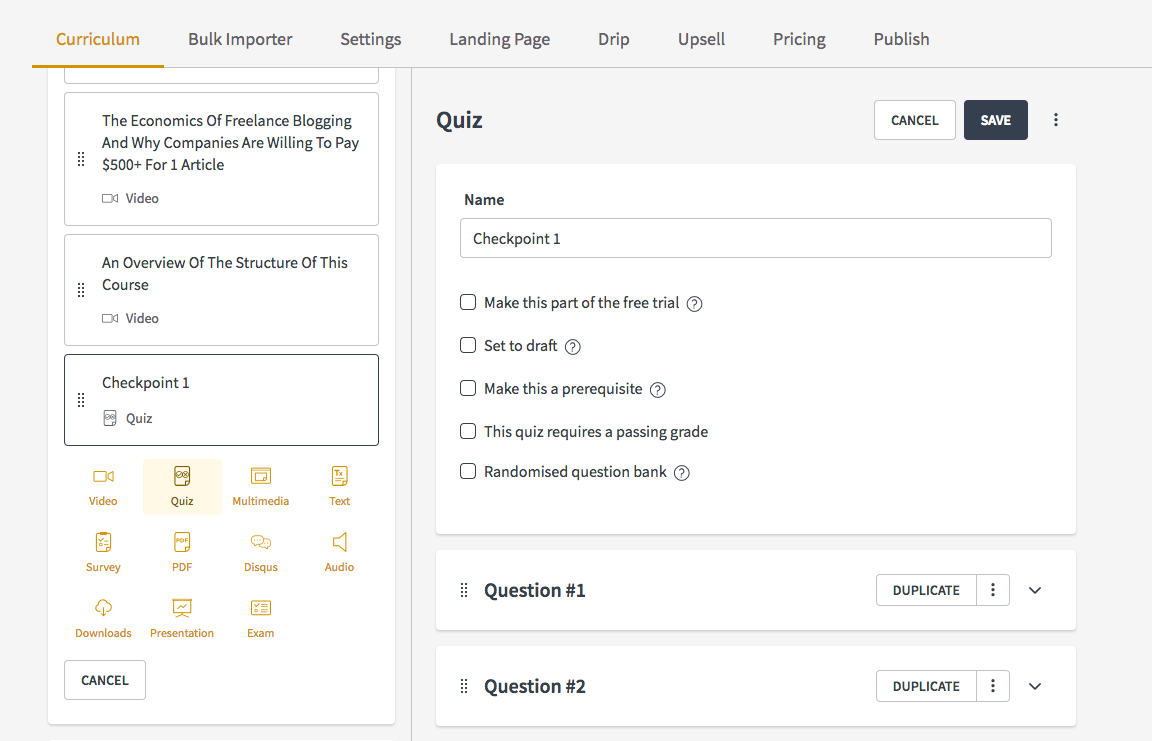
Add interactivity
Making your online course more interactive, versus just a one-way flow of information also keeps students engaged. Here are some additional elements you can add with just a click in Thinkific:
- Quizzes – Throw in a quiz for each chapter to test students.
- Surveys – Ask students to provide long-form answers or describe their progress.
- Feedback forms – Collect feedback from students so that you can incorporate it into your online course and make it better.
- Gamification – Award prizes to students based on progression, and show their progress through your course to urge them on.

Make your content engaging
We covered this in the section on content creation so I won’t go into much detail here. The basic idea is that your course content should make students want to keep going.
When you watch Netflix, you’ll notice that the most binge-worthy shows are those that build curiosity at the end of each episode. They tease you so that you want to keep watching. You can do something similar at the end of every lesson.
Also keep your teaching style conversational. Often, if you’re reading out of a teleprompter, it can sound robotic. Instead, just be yourself and talk to the camera like you’re talking to a friend. This makes it sound more natural.
Bring students back
If your course takes more than a few hours to complete, chances are your students won’t finish it in the first sitting. When they log off, you want to stay in their minds so that they come back. Here are a few things you can do:
- Send reminder emails letting students know that they haven’t finished the course. You can easily set this up with a few clicks in Thinkific.
- Set up accountability groups by pairing students with a partner who will finish the course with them.
- Create a student Facebook Group where students can interact with you and others.
- Offer a completion certificate that students can only receive once the entire course is complete. This is a built-in feature in Thinkific.
- Run a regular group call with students (perhaps once a month) to oversee their progress.
- Keep track of student progress in your Thinkific dashboard and personally reach out to anyone who is falling behind.
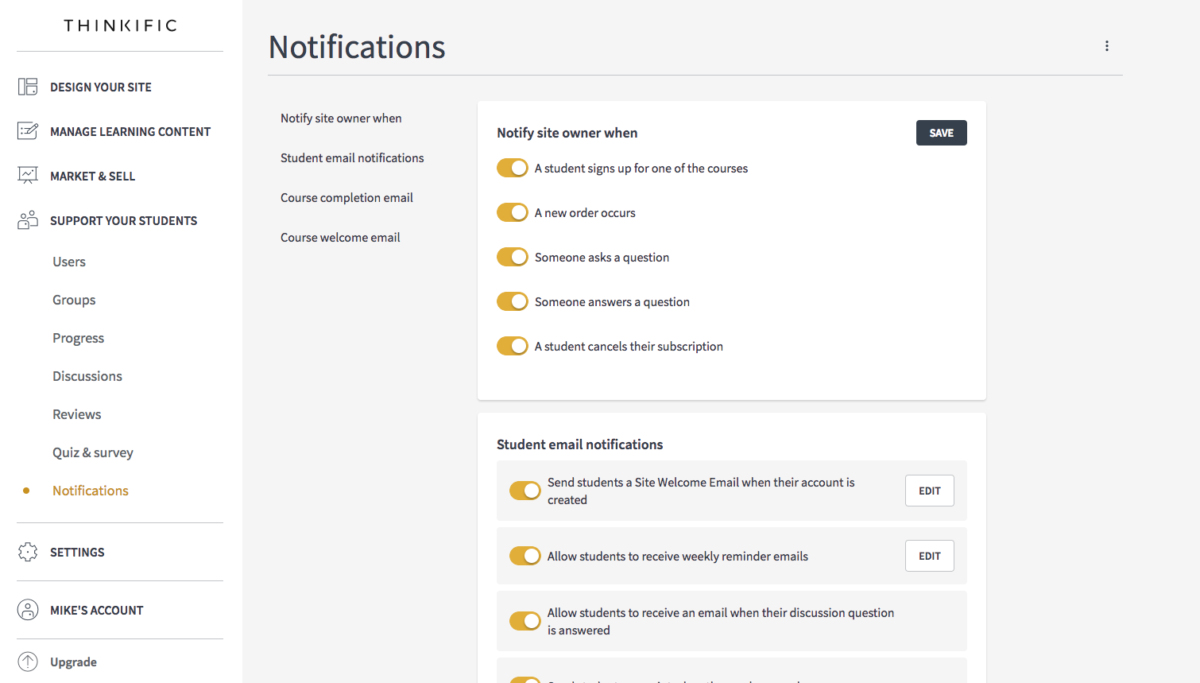
When you come across stats for online learning, you’ll often see that completion rates for online courses are pretty low. The industry average is about 3-5% but this includes courses on other platforms like the ones we’ve mentioned previously.
However, when using all the features in Thinkific and following some of the principles outlined above, you’ll find that completion rates are up above 90%. Carrie’s courses are a prime example of this. Her students are extremely successful, and that’s why she has such a strong brand in the industry.
CONCLUSION
What Will Your Legacy Be?
An annoying characteristic of Leonardo da Vinci was that he would often leave things unfinished. For every work of art he produced, like the Mona Lisa, he had dozens of paintings that were left half-complete.
He also left behind reams of notes on art, science, and engineering, that he’d intended to publish as books. Had he published them, he’d have had a greater impact on future generations.
Right now there are people out there who can benefit from learning the topic you teach. There may already be other online courses on the same topic out there, but they do not have your unique perspective.
By reading this post, you’ve embarked upon a journey to teach what you know by creating an online course. You’ve already started, even if you haven’t actually done any of the exercises yet. The only question is, are you going to finish?
Or will you leave it unfinished and deprive the world of your expertise?
This guide was originally published in August 2018 and was updated in August 2023 with new resources and downloadable guides.
